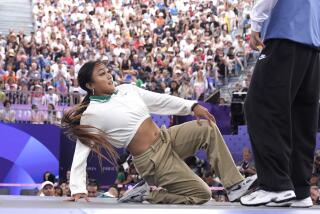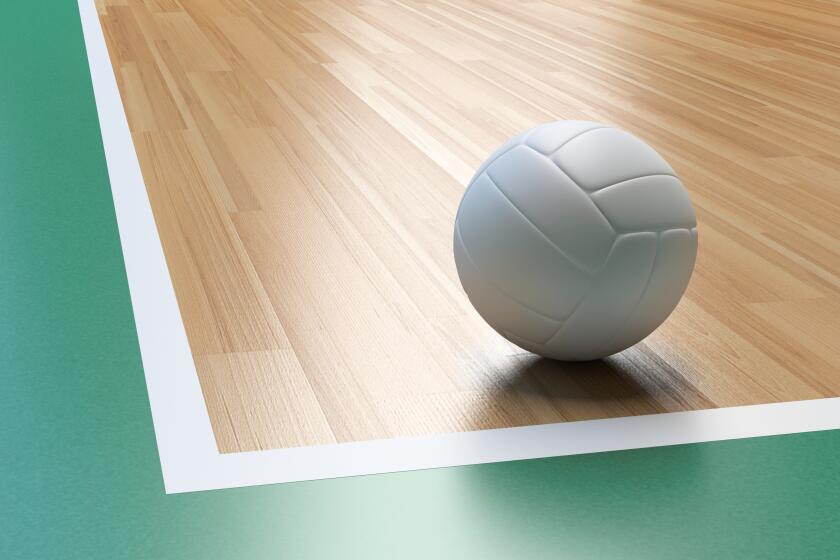Racism Still Goes Unchecked
The toughest high school athlete in town is not a fighter.
“There are better ways,” Chad Bates says.
The toughest high school athlete in town has spent seven years walking into places where he fits like jello on rye.
Seven years, and always smiling.
“I say, the heck with people, I’m going to be who I am,” he says. “And I’m a nice guy.”
The toughest high school athlete in town plays hockey, but he is not an enforcer or goon or tough guy.
He is black.
He is the only black player on his team, and one of about 15 to 20 among the 3,000 players in the Southern California Amateur Hockey Assn.
That should not make this a story, but you know it does.
The sports world was recently awakened to the barriers remaining in hockey when Edmonton’s Mike Grier--the first black NHL player born and schooled in the United States--was called a racial epithet by Washington’s Chris Simon, who recently completed his three-game suspension.
Chad Bates saw that on ESPN and winced.
He has experienced three similar incidents in the last two years.
Two seasons ago, while playing for the Marina Cities club in Culver City, he was called the “n” word by an opponent from Norwalk, whom he proceeded to beat up.
Bates was ejected from the game, the opponent was not, and Bates immediately made a decision.
“Fighting back wasn’t going to work,” he says. “I realized I had to beat them on the ice.”
Early last season, while playing for Marina Cities against a club from Thousand Oaks, the same thing happened. This time, Bates responded with a hard check.
Turns out, that didn’t work either.
When the teams met again in January, two players from Thousand Oaks taunted him with racial epithets and monkey noises. His coach fought the two boys afterward, and was suspended for a year.
“Sometimes,” says Bates, 17, “all of this is real disappointing.”
Just disappointing enough to keep him playing.
This winter, the toughest high school athlete in town has returned for more, competing for a Torrance team in what will be his last season before college.
He does not play in the hope of reaching the NHL--his average talent, 3.8 grade-point average and 1,220 SAT score have pointed him in a different direction.
He does not play because it increases his popularity at Culver City High--”People look at me like, ‘You play what?’ ”
He plays because he still enjoys it, and because he still wonders.
Do you think maybe people need to see him play?
“Sports is so great because it allows everybody to know about everybody else in society,” he says. “Maybe by me playing, some of those hockey people will realize, ‘Hey, there’s black people out there too.’ ”
*
The first time Chad Bates walked into a store to purchase hockey equipment, he walked out with a pair of football shoulder pads.
He didn’t learn to ice skate until he was 10. He had never even seen a hockey game until then.
One minute, he was playing roller hockey with his buddies around his Culver City apartment complex.
The next minute, they were on the ice at a nearby rink, introduced to a sport that fascinated Bates with its combination of skating and hitting.
He thought the next obvious step would be to join a junior league team, which previously had been all-white.
Neither he nor his mother realized that once he had, many of his buddies would be gone.
“I really didn’t know what hockey was like,” said Marci Matt, his mother. “This being Culver City, I was surprised his team was not diverse.
“I never had a concern that he would be treated the way he has been treated.”
One African American friend did start with Bates.
“But we were the only blacks,” Bates said. “He gave up. There is an intimidation factor there.”
The only concrete evidence about blacks in hockey is, there are hardly any. Of the 624 players on NHL rosters, only seven are black.
Most agree this is because the sport is still rooted in small-town Canada. The popularity gains made in this country have occurred mostly on a northern small-town or suburban level, where the demographics are mostly white.
“Hockey just isn’t in our faces,” Bates said of his African American friends. “Sports is something that is passed down through your roots, and hockey is not passed down to any of us.
“I see 6- and 7-year-olds out on the ice and I think, ‘Did they establish that idea by themselves?’ I don’t think so.”
Although his divorced mother and father were supportive--Marci even stopped doing her nails and hair to help pay the high cost of rink time--Bates knew immediately that he was on his own.
“For a while, I felt like the oddball,” he said. “I felt, if I messed up, everyone would look down on me more.”
He met many nice people, and decided those feelings were nothing more than his imagination. But then he started playing well enough to move up the ladder.
“In hockey, when somebody is good, kids say the meanest things to get under their skin,” said his buddy, Ryan Ramsey. “Chad being black, they use that.”
The first time somebody hit him with the “n” word was two years ago, against Thousand Oaks, when Bates said he was finally feeling comfortable.
“Some guy yelled it at me and I said, ‘What?’ ” he recalled. “I couldn’t believe somebody was actually saying that. I lost it.”
After delivering the beating and being ejected from the game, Bates was counseled by his coach on the foolishness of fighting back. The kid and his father also apologized.
“But it almost didn’t matter,” Bates said. “It was like, I realized people out there were still ignorant enough to use that language.”
Said his mother, “I don’t regret the experiences he’s had, because they opened his eyes to the realities of the world.”
Last season his eyes were opened further when it happened again, and he did not fight back, and the offender shut up.
“I was proud of how I handled it, I thought it was over,” he said.
It was only beginning.
On Jan. 11, against Thousand Oaks again, Bates was checked hard by the same player, who with a buddy began the same derogatory taunting. This time they included Bates’ two African American teammates in the abuse.
Bates checked him back. They were both given penalties. While sitting near each other in the penalty boxes, Bates could hear the boy begin again.
Using the “n” word. Making monkey noises. Cracking racial “jokes.”
According to a police report, witnesses corroborated Bates’ claim that the other boy used racial slurs.
There was a police report filed because Bates’ coach, screenwriter and comedian Marty Keegan, confronted the two boys on the ice after the game.
He scolded them for their behavior, then walked off the ice. They followed him, a fight ensued, and police were called.
The police report notes the referee’s claim that Keegan was forced to defend himself against the two boys.
The SCAHA Penalty/Conduct Review Committee nonetheless suspended Keegan for a year, while the offending boy was suspended for the rest of the season.
Marci Matt was furious.
“His coach ended up being suspended for a year for taking up for my son, that’s the way I saw it,” she said. “I felt like they had no interest in teaching ethics and life rules to these young men.
“This was a hate incident, but not treated as such.”
Pam Levin, commissioner of SCAHA, disagreed.
“We deplore what happened, and we acted on it immediately,” she said, noting the offending player was suspended in accordance with their rules clause prohibiting racial slurs.
Levin said the Keegan incident was a separate matter--”No matter what happens, we do not condone an adult hitting a minor,” she said. “Mr. Keegan was right to be mad. But you walk away.”
Keegan said these “minors” were large teenagers--it was a league for ages 15-17--and that he didn’t have a choice.
“And what kind of message does this send to Chad about white society?” asked Keegan, who is white. “That the coach who protects him gets a longer suspension than the player who slurs him?”
Countered Levin: “This is not a situation that happens on a continuing basis. We are fortunate that this was an isolated incident.”
It is certainly isolated in that, in the end, the one who has to carry it all is Bates.
He and others agree with Levin that this does not happen on a continuing basis.
“By and large, things are fine,” said Rodney Guinyard, an African American parent of two junior players.
But the toughest high school athlete is town wonders these days if he is really all that tough.
“I have not been the same since that happened, and I don’t know why,” he said. “I’ll go out to the ice all fired up, but end up disappointed in myself.
“I don’t want to blame anything. I don’t know what is wrong “
He continues to love the sport so much that he looks the other way when folks refer to him as, “No. 22, the black guy.”
“I admire him,” said his friend Ramsey. “If I was him, I don’t think I could hang with people that different from me.”
And who does Chad Bates admire? Whose poster hangs on his bedroom wall?
“My mom gets mad because the walls are so bare,” Bates said, shrugging. “I guess I idolize nobody. I guess I want to go my own way.”
More to Read
Get our high school sports newsletter
Prep Rally is devoted to the SoCal high school sports experience, bringing you scores, stories and a behind-the-scenes look at what makes prep sports so popular.
You may occasionally receive promotional content from the Los Angeles Times.







